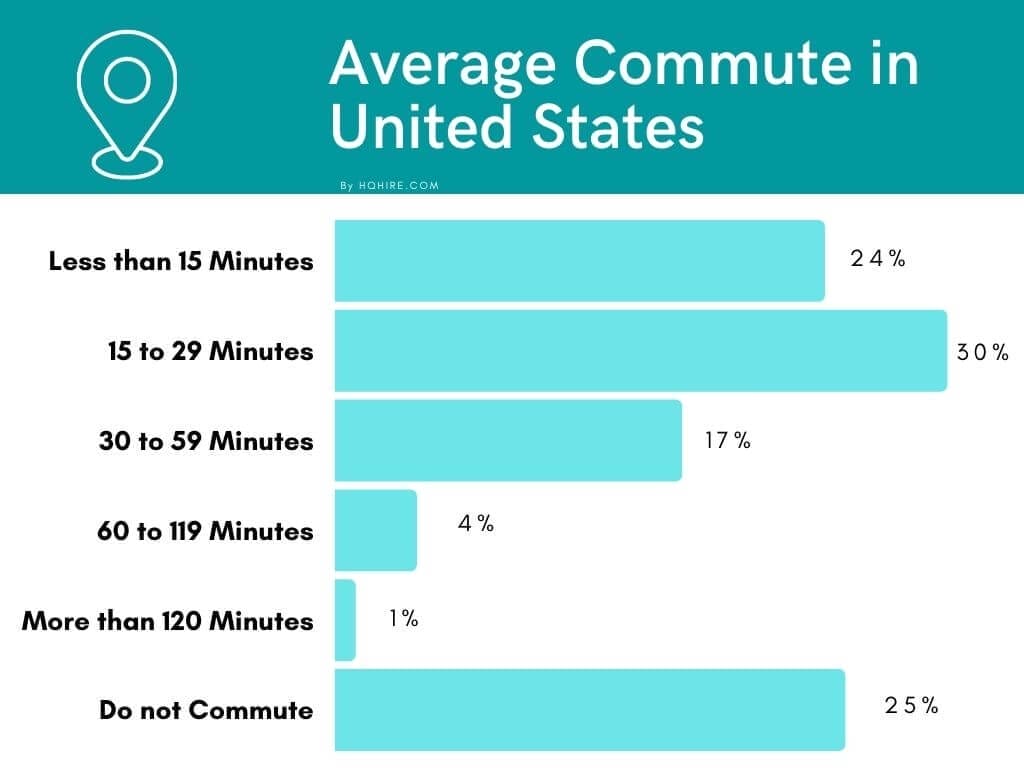Research found that employees are 13% more productive while working from home, and with clear productivity benefits for both employers and employees, the shift to remote work is a workplace trend that will continue to grow in the future.
With advancement of remote working software and better virtual communication technology, office workers are given the option to work from anywhere, developing into an more agile team that are happier and more productive.
How Working From Home Increases Productivity
Traditionally, managers and business owners resisted allowing their employees to work from home due to the belief that they would be less productive than their office-working colleagues.
However, research from the Quarterly Journal of Economics shows that compared to workers who do not have the option of remote work, remote workers show an overall increase in employee well-being, increase productivity, engagement, and innovation.
Working from home significantly increases the productivity of employees:
- Productivity: 13% performance increase in their work.
- Working: 9% increase in time spent working shifts, taking fewer sick days, and shorter breaks.
- Performance: 4% increase in performance due to reduced distractions.
- Job Satisfaction: 22% reported being happier at work.
- Retention: Lower staff losses over time
When businesses are willing to invest in their employees who choose to work from home, they can reap the benefits of employee satisfaction which leads to an overall increase in workplace productivity, and 77% of all workers agree.
Productivity Benefits of Working From Home for Remote Employees and Employers
There are many productivity benefits to working from home, and if you can get past some of the initial challenges, it can be a very rewarding way to work.
You can work in peace and quiet, and avoid the noise and distractions of an office. You also have more control over your work schedule and can make adjustments as needed. Working from home has many benefits and here are some of the best productivity benefits of working from home.
1. Reinvest your commute time
The United States Census Bureau calculated that in 2019, the average one-way American commute had blown out to 27 minutes. That adds up to almost one hour each day!

If you work from home, the average full-time worker will save around 250 hours (or over 10 full days) every year that they would otherwise have spent commuting.
That’s a lot of extra time to have in your pocket. Using that time in a useful way – and not just scrolling on your smartphones – will allow you to develop a more positive mindset for the time you do spend working.
Ways to reinvest the extra time you’ve saved from not commuting to work
There are many things you can do with the extra time you’ve saved from not commuting to work.
Put in more hours in your current job
If you’re paid by the hour, this is extra cash in your pocket. If you earn a salaried wage, this extra commitment will bode well for future promotional or pay rise opportunities.
Start your side-hustle
If you’ve always wanted to activate your hobby or you have a great idea for earning extra cash, working from home allows you a few extra hours in the day to realize your dreams.
Work to improve yourself
- Read more (join a book club to help you stick to it)
- Go to the gym
- Take your dog for a long walk at the start and end of your day
Work to help others
- Volunteer at a shelter or help distribute food
- Volunteer at your child’s school
- Help your neighbors tend their garden
Can you work from home and travel?
Yes, for those who enjoyed their commute time because it gave them a dedicated break in the day where they could listen to the car radio, catch up on their favorite television show, or keep on top of the daily news cycle, you can work from home and travel.
Establish a routine where you have a ‘mini commute’ that can be anything from going to the local café for your favorite cup of joe or taking a 15-minute walk around the block before work.
By establishing a routine that works for you, you’re in a good mindset to have a productive day working from home.
2. Drown out the distractions
For most people, it is easier to focus on the task at hand when you work from home. Without having to ignore the constant noise of open-plan offices, address face-to-face questions, or take part in idle chatter throughout the day, working from home is quieter and more relaxed than office-based work.
However, real-time communication tools do make it easy for your colleagues to contact you at any time for any reason. You can make full use of this technology to set your notification settings to ‘busy’ or ‘unavailable’ so that you can settle in for a stretch of uninterrupted work.
3. Count your pennies
When your workforce works from home, business owners can do away with having a dedicated office altogether.
Not only will this save a bucket of cash on rent, electricity bills, printer toner, server costs, and stocking the pantry with tea and coffee, but the money you save will allow you to hire more staff and increase your company’s ability to do more with less money spent.
Even if you find yourself needing to collaborate face-to-face every now and then, you can hire an agile or co-working office space for a couple of hours, a day, or even a week.
4. Activate a healthier lifestyle
There are a number of ways in which working from home can help you lead a healthier life, as long as you’re proactive about it. And when you’re feeling good mentally, spiritually, and physically, you’re in the best shape to complete your work to the best of your ability.
To lead a healthier life, you can:
- Use your former commute time to get more steps in, join a gym, or practice self-care exercises like mindfulness or yoga. You don’t need to splash a lot of cash, for there are many free online resources for you to use.
- Be thankful that you’re less likely to catch the bug that everyone in the office seems to be getting. Not only does this keep you healthier overall, but workers from home are less likely to take sick days throughout the year.
- Set your office space to suit you so that the temperature, airflow, and lighting are just right.
- Choose your own brand of beverages.
- Make your own healthy lunches.
5. Introverts rejoice!
There are many ways in which people prefer to work. For introverts, working from home is preferable to being in an open-plan office because they do not have to constantly manage their interactions with their colleagues throughout their working day.
For introverts, working from home means that they can get the job done in a space where they are most comfortable. Not only does this reduce stress and anxiety, but when workers are more relaxed, they’re more likely to perform as productively as possible.
For managers, understanding how their employees work is a great way to increase productivity. Even if it is only two to three days per week, allowing introverts to work from home will show marked productivity upswings thanks to healthier and happier workers.
6. A better work-life balance
According to the Productivity Commission, people prefer to have the option of working from home because it allows them to avoid a lengthy daily commute and promotes a better work-life balance.
‘Work-Life balance’ is a catch-all term that includes the activities you do to minimize your stress and anxiety by establishing stable and sustainable ways to work.
When you feel better, are able to achieve more in your life outside work, and have the choice to pursue non-work interests, you’re more likely to be in a positive mindset that will benefit your workplace productivity.
Here are some examples of work-life balance initiatives:
Offer flexible leave policies
No longer are you stuck with a rigid number of sick and annual leave days, but you can flexi-time your time off with a catch-all term called PTO, or ‘paid time off.
Encourage healthier ways of working
This includes providing money for standing desks, sponsoring gym memberships, and providing opportunities for lunchtime yoga sessions.
Provide flexible scheduling options
This not only lets you start and finish work at times that suit you, but it means that you can attend to family duties like picking up your children from school or making your daytime appointments.
Provide creative incentives
While paid bonuses are welcome, creative incentives like holiday vouchers, long weekends, and afternoons off are a great way to keep people motivated to maintain their productivity, while contributing to better work-life balance.
Providing educational support
Programs such as tuition assistance and reimbursing employees for attending conferences and development sessions help people focus on their continuing growth and lifelong learning.
7. More agile meetings
One of the most common ways for workers to be distracted from their work is having to attend meetings with their colleagues. The last thing you want to do, especially when you’re really hitting those productivity marks, is to stop your work to discuss unrelated issues with your colleagues.
Not only is it distracting you from your task, but it takes significant mental work to get back to where you were before you were distracted.
Of course, we still have meetings when we work from home. But in order to remain productive, we now have to navigate these meetings with more authority. For example, it might suit the cohort of remote workers to provide a daily update rather than sit through a meeting, at a time that suits them best.
How to Become More Productive When Working From Home
Working from home can increase productivity by more than 13%. However, if you want to increase your productive working from home, here are some tips that you may want to consider.
1. Embrace the Power of Breaks
Employees who work remotely often use time saved from getting to and from work by working longer hours to get more work done.
It’s easy to forget the rejuvenating effect of breaks and remote workers often find themselves glued to their screens,
However, taking breaks is a proven method to maintain productivity. Consider adopting the Pomodoro Technique, a time management method that is highly effective for busy remote workers:
- Do 25 minutes of focused work
- Followed by a short, recharging break
- Repeat the process
This simple strategy can do wonders for your focus and overall well-being. You can also explore various break activities such as a brisk walk, a healthy snack, or a quick meditation session to keep your mind sharp and energized.
2. Craft a Consistent Schedule
One of the secrets to productivity lies in maintaining a structured routine separating your work and personal time, this not only helps you to stay productive and prevent you from getting burnout, but help you boost productivity for the long run.
- Identify your peak productivity hours
- Schedule your most demanding tasks during these times for optimal results.
Designate specific work hours and stick to them religiously.
Do not continue working when you are outside of work hours.
By aligning your remote schedule with the rhythm you had in the office, you create a sense of stability and efficiency.
A good tip is to use small business organization apps to plan your daily tasks and set realistic deadlines to stay on track.
3. Equip Yourself with the Right Tools
The transition to remote work comes with its unique set of challenges, but the right tools can make all the difference.
Invest time in training sessions to familiarize yourself with essential software applications that can help you improve productivity at home.
Remote business collaboration apps and tools facilitating seamless communication are crucial for a productive work environment.
4. Harness the Power of To-Do Lists
People who work in an office have a to-do-list, and you should create harness the power of a to-do-list to help you stay productive while working from home.
Having you own to-do list can acts as your guiding compass.
- Encourage the use of to-do lists among your team members to enhance organization and productivity.
- Regularly scheduled meetings provide a platform to discuss and prioritize projects, fostering effective communication crucial for remote success.
Leverage the simplicity of to-do lists to prevent task hopping and maintain a streamlined work process. This simple list can help employees stay productive at home.
5. Tame Distractions for Laser-like Focus
While the freedom of remote work arrangement is liberating, however the main downside of working from home is probably the unforeseen distractions that comes from a change of work environment.
For remote employees to stay productive, you need to silence your phone, create a dedicated workspace, and steer clear of tempting areas that may divert your attention.
Creating your own home office can minimize distractions, ensuring that you remain fully engaged in your tasks, promoting a productive work environment.
Read Also:
- How to Become a Remote Developer: Your Complete Guide to a Digital Nomad Career
- How to Become a Blockchain Developer: Complete Guide to a Career in Blockchain Technology
- How to Become a SQL Developer: Complete Guide to a Career in Database Development
- How to Become a Freelance Travel Writer (Step-by-Step Guide)
- How to Become a Remote Freelance Technical Writer (Step Guide)
Join over 11,000+ achievers who are committed to achieving their career goals!
Join over 11,000+ achievers who are committed to achieving their career goals!






